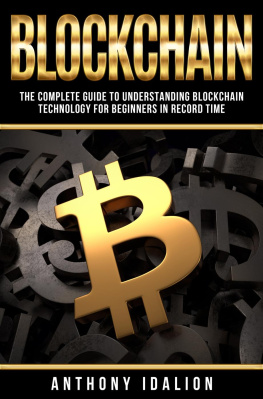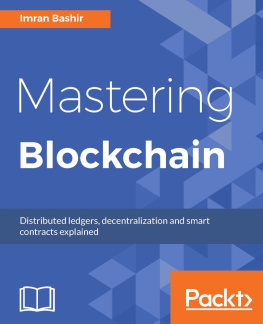Stake Hodler Capitalism: Blockchain and DeFi (Decentralized Finance)
Table of Contents
Disclaimer
Copyright 2021
All Rights Reserved.
This e-book contains material protected under International and Federal Copyright Laws and Treaties. This e-book is intended for personal use only. Any unauthorized reprint or use of this material is prohibited. No part of this book may be used in any commercial manner without the author's express permission.
Scholarly use of quotations must have proper attribution to the published work. This work may not be deconstructed, reverse engineered, or reproduced in any other format. The entire e-book in its original form may be not be shared with other users who don't obtain proper access to it.
Introduction
Entering into the blockchain ecosystem can seem a little bit hard and confusing for anyone, regardless of their background. Most people lose out on what blockchain technology and cryptocurrency as a whole offer because it's hard to identify ambiguous opportunities. The terminologies look a bit too technical and confusing. However, blockchain is a disruptive technology that looks promising and enticing to enthusiasts of decentralization and efficiency.
This book explains technical concepts in the simplest human-readable format. You will get to understand the key fundamentals of blockchain technology. By the end of this book, you will have sufficient knowledge of blockchain and DeFi that helps you identify strengths, weaknesses, opportunities, and threats.
Author's Note
This book series is one of the masterpieces I'm most proud of. I attribute this success to god, first and foremost, my mother and wife, family, and friends. A big part of what shaped me as the person I am now is when my dad passed away in 2018, which left me wondering about life's real purpose. At that point, I realized that the joy comes from the journey and the most rewarding feeling comes from helping other people.
Blockchain has had its fair share of disruption in our lives since Oct. 31 st , 2008, which is the date Satoshi Nakamoto the creator of bitcoin, published his paper titled "A Peer-to-Peer Electronic Cash System." Nevertheless, bitcoin has had its direct effect on my life. I started delving into blockchain in 2017 when I got the idea of researching a blockchain-related ecosystem project; that was when I fell in love with blockchain and DeFi. In the "Stake Hodler Capitalism" book series, we will delve deeper into why I and many others have been fascinated to the point of obsession with Blockchain, cryptocurrencies, and decentralized finance.
Chapter 1: DeFi Apps: The Ultimate Killer Apps in Blockchain
Whether you have heard about the DeFi (Decentralized Finance) hype or you haven't heard about it, it already started being directly a part of our day-to-day lives. Throughout this chapter, we will break the components of DeFi into smaller, easily digestible subparts.
What Is DeFi?
DeFi or decentralized finance is a movement started by different researchers to create a new and open-source financial system that anyone can access without requiring trusted intermediaries or central authorities such as banks, brokerages, or exchanges. Cryptocurrencies are known to operate on a blockchain or public ledger technology implemented specifically as the backbone for it; the advantages offered by each of these smaller ecosystems formed by cryptocurrencies are unimaginable. Bitcoin (although many currently consider it a store of value similar to gold) is still the first, most known, and best example. Payments can be made through the Bitcoin network, i.e., a network of decentralized independent nodes to confirm transactions.
To achieve this, DeFi relies heavily on cryptography, blockchains, and smart contracts. Before referring to this whole idea as decentralized finance, it was referred to as "open finance." A smart contract is the main building block of DeFi. On DeFi platforms, most people are permitted to lend or borrow funds from others, guess on changes in price on a couple of assets using derivatives, trade cryptocurrencies, insure against risks, and go ahead to make interest in a savings-like account. DeFi applications provide high risk-reward ratios, but joining some of these projects can be high risk in itself. Vetting out the best projects is a cumbersome process, but understanding the fundamentals will help you make the best investment decisions for Blockchain and DeFi.
Cryptocurrencies are known to operate similarly to the traditional banking systems we have. When it comes to payments, we can achieve the same results with blockchain. The killer edge that blockchain has over conventional banking systems is the immutable and decentralized nature. Decentralization can give you a hundred percent uptime versus what traditional payment systems offer nowadays. The immutability of blockchains guarantees the elimination of fraud. Bitcoin (although many now consider it a store of value like gold) is still the first and best example. Alice can pay Bob in Bitcoin without relying on a financial intermediary like banks. Instead, payments can be made through the Bitcoin network, i.e., a network of decentralized independent nodes to confirm transactions.
To recap, for all of this to occur, DeFi relies heavily on cryptography, blockchain, and smart contracts. Don't worry if you don't know what a smart contract is or how it simply functions. We will go over Smart Contracts in Chapter 3 of this book. If you want more deep dive into Smart Contracts, you can check out Part 2 of this book series titled: "Stake Hodler Capitalism: Smart Contracts and DApps."
Cryptography
Encryption is considered to be the core component of cryptography. More generally, encryption is creating and analyzing a protocol that prevents third parties or the public from reading or accessing data stored or transferred through a communication medium. The human-readable format for the DeFinition of encryption is a BlackBox that you enter a piece of data to and use a key to encode it, and this process can't be reversed except with a unique key that two or more parties can share.
At the heart of modern encryption are various aspects of information security such as data confidentiality, integrity, authenticity, and non-denial. Modern cryptography is at the intersection of mathematics, computer science, electrical engineering, communications, and physics. Cryptographic applications include e-commerce, chip-based debit cards, digital currencies, computer cryptography, and military communications.
Before modern times, cryptography was almost synonymous with cryptography that turns knowledge from readable to unreadable nonsense. Encrypted message transmitters use decoders only for their intended recipients, making them inaccessible to attackers. The names Alice ("A") for the sender, Bob ("B") for the intended recipient, and Eve ("Block") for the attacker are often used in cryptographic literature. Since the development of rotary encryption machines during World War I and the advent of computers during World War II, encryption technology has become more complex, and its applications have become more diverse.
Modern cryptography is primarily based on mathematical theory and computer science practice. Cryptographic algorithms are designed based on assumptions about computer security, making it difficult for attackers to exploit such algorithms. It is theoretically impossible to hack a well-designed system like this, but in practice, it is possible with quantum computers, but that is a topic beyond the scope of this book. For now, let's think of the use of cryptography as the safest way to store and deliver data. Hence, these circuits are called "data safe" if they are well designed.





![Eric Traub [Eric Traub] - Learn Blockchain Programming with JavaScript](/uploads/posts/book/120568/thumbs/eric-traub-eric-traub-learn-blockchain.jpg)
![Bellaj Badr [Bellaj Badr] - Blockchain By Example](/uploads/posts/book/119701/thumbs/bellaj-badr-bellaj-badr-blockchain-by-example.jpg)
![Kirankalyan Kulkarni [Kirankalyan Kulkarni] - Learn Bitcoin and Blockchain](/uploads/posts/book/119684/thumbs/kirankalyan-kulkarni-kirankalyan-kulkarni-learn.jpg)